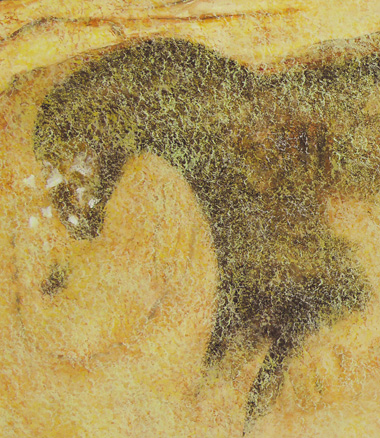
MICHEL LORBLANCHET. Art pariétal: grottes ornées du Quercy. 448 pages, numerous colour & b&w illustrations, tables. 2010. Paris: Rouergue; 978-2-8126-0164-4 hardback €49.
Review by April Nowell
Department of Anthropology, University of Victoria, Canada
(Email: anowell@uvic.ca)

Much like its subject matter, Michel Lorblanchet's 2010 volume, Art pariétal: grottes ornées du Quercy, is a spectacular work of both art and science. It represents forty years of research by Lorblanchet and his colleagues on the painted caves of the Quercy in southwest France. While this volume contains detailed information on the type, frequency and layout of the images in each of the caves, the associated faunal and archaeological remains, the geological and environmental contexts, and the results of pigment analyses and dating initiatives, the one thing the reader will not discover in this book is what it all 'means' and for this Lorblanchet makes no apologies.
In his introduction, the author emphasises that Palaeolithic images most probably had multiple, diverse meanings that may never be fully understood. In this, Lorblanchet joins other scholars such as Margaret Conkey who have long argued that the search for grand, vitalistic schemes to explain Palaeolithic art (e.g. hunting magic, fertility magic or shamanism) has become stale and that instead of seeking specific meanings researchers should consider why the making of imagery might have been meaningful to certain people in certain places at certain times (Conkey 1997: 359; see also Nowell 2006). This shift away from grand explanatory frameworks towards a consideration of the art as local, historically-situated phenomena has resulted in two different but interrelated approaches to studying Palaeolithic imagery. The first emphasises the social production of Palaeolithic visual cultures and the place of painted caves within the physical and cultural landscapes of Ice Age peoples (e.g. Conkey 1993, 2010; Dobres 2001). The second focuses on the meticulous, almost forensic, reconstruction of context, the materiality of cave art and the knowledge and gestures of Upper Palaeolithic peoples as they moved through space creating the imagery (e.g. Tosello & Fritz 2007; Menu 2009). As Conkey (1993) has argued, the latter approach is perhaps our surest way towards reconstructing the former and with this volume, Lorblanchet is well positioned to move the field forward.
The book is divided into three parts flanked by an introduction and conclusion. The first part, 'Grands sanctuaires archaïques', and the second, 'Pettit sanctuaires archaïques', focus on the six principal and the dozen or so smaller painted caves in the region that date to the Gravettian. Half the volume is devoted to a detailed study of the richest cave in this group, Pech-Merle, best known for its spit-painted 'Panel of the spotted horses' and its enigmatic 'Wounded man' (an anthropomorphic figure with what looks like multiple spears stuck into it); researchers have however also recorded more than 600 non-figurative signs, 74 images of animals and approximately 20 figures identified as human in this cave. The third part of the book, 'Sanctuaires magdaléniens', presents research on eleven caves painted between 16 000 and 13 000 BP which, according to Lorblanchet, differ from the earlier caves, in theme, technique and style. The volume's conclusion departs from the previous 400 pages of relatively straightforward facts and presents instead a descriptive and warmly personal account of the art and 'ritual feel' of these underground 'sanctuaries' based on a lifetime of observations.
Among the strengths of this book are the detailed descriptions and inventories of the cave images and clear and precise maps locating these. This level of detail is most welcome as it allows other researchers to build on Lorblanchet's work. For example, instead of the frustratingly brief 'seven geometric signs' that characterise some reports, Lorblanchet tells the reader exactly what they are, where they are located and what they look like. This is supported by the beautiful colour photographs and drawings that illustrate the volume throughout; physically, it is short and wide and this landscape format is ideal for laying out a series of photographs, progressing, for example, from barely visible engraving to enhanced photograph to reconstructed drawing. Numerous foldouts that reveal a large panel in its entirety are of further help. While one may not agree with all of Lorblanchet's interpretations (I personally could not see 'femaleness' in natural rock formations that were clearly obvious to the author and his team) there are truly no shortcomings in a book which really sets the standard for the regional analysis and presentation of Palaeolithic art data.
This book will please many readers: advanced undergraduates, graduate students and professionals with an interest in rock art of any period will find its methodological approaches useful; those who are more specifically concerned with the lives and visual cultures of Upper Palaeolithic peoples will find sustenance here; and, for its stunning photographs alone, non-specialists with an appreciation of Palaeolithic art will also enjoy this wonderful book.